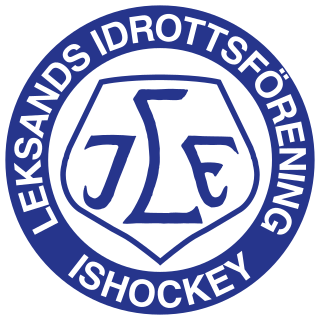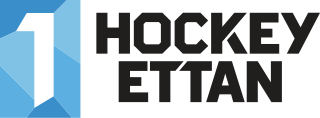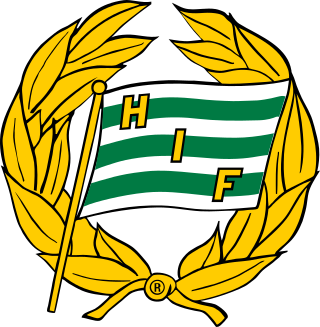
Leksands Idrottsförening is a Swedish professional ice hockey team from the town of Leksand in the region of Dalarna. The team plays in the top-tier league, Swedish Hockey League (SHL), after succeeding through the 2019 SHL qualifiers and thus earning promotion to the SHL. The club's home arena is Tegera Arena, which seats 7,650 spectators.
Hammarby IF Ishockeyförening was a Stockholm-based professional ice hockey team that for most of its history played in Hovet. Hammarby IF started playing hockey in 1921, playing their first matches using a group of curious bandy players. Hammarby were giants in the early history of Swedish hockey, playing in Sweden's top league from the birth of Swedish organized hockey in 1922 until 1957. During that period, they were crowned Swedish champions eight times in 13 attempts. The rest of their history was more modest, having qualified for play in Elitserien only twice, however during their entire existence, they never played in a lower league than the second tier. As of 2013, five seasons after the club's bankruptcy, Hammarby is 17th in the Marathon standings for the highest division of Swedish ice hockey.

Rögle BK is a Swedish professional ice hockey club from Ängelholm that has been playing in the SHL since the 2015–16 season. Rögle has previously played in the SHL in 1992–1996, 2008–2010, and briefly in 2012–13.

HockeyAllsvenskan is a professional ice hockey league, and the second-highest league in the Swedish ice hockey system, after the SHL. Since the 2009–10 season, the league has consisted of fourteen teams.
Kvalserien, also known as Kvalserien till SHL, was the Swedish round-robin ice hockey tournament to qualify for play in the next season of the Swedish Hockey League, Sweden's top-level ice hockey league for men. It was replaced by a playoff round in the 2014–15 season.

Huddinge IK, is a Swedish ice hockey team from Huddinge, a southern suburb in Stockholm County. The team is currently playing in the third highest league in Sweden, Hockeyettan. In the middle of the 1990s, a women's floorball section was founded, whose A-team advanced to Elitserien, the highest league, in 2008.

Hockeyettan is the third tier of ice hockey in Sweden. As of the 2015–16 season, the league consists of 39 teams divided geographically into four groups. Hockeyettan operates a system of promotion and relegation with HockeyAllsvenskan and Division 2.

Hammarby IF Ishockeyförening is an ice hockey club founded as "Bajen Fans IF" in 2008 by supporters of the previous incarnation of Hammarby Hockey which went bankrupt that same year. The club plays in Hockeytvåan, the fourth tier of Swedish men's ice hockey, since the 2021–22 season.
The 2012–13 HockeyAllsvenskan season was the 8th season of the HockeyAllsvenskan, the second-highest level of ice hockey in Sweden. The regular season began on 12 September 2012 and ended on 2 March 2013, with the following playoffs and Kvalserien tournaments running until 5 April 2013. Leksands IF, following a season marked by financial instability and scandal, secured first place in the regular season standings, and continued to the qualification round for the 2013–14 SHL/Elitserien season, along with second-place Södertälje SK, third place VIK Västerås HK, and playoff winner Örebro HK. Meanwhile, 13th- and 14th-ranked Tingsryds AIF and Karlskrona HK were forced to defend their places in HockeyAllsvenskan for the 2013–14 season.
The 2012–13 Division 1 season in Swedish hockey was played from 12 September 2012 to 17 February 2013, with a number of playoff and promotion/relegation tournaments continuing until 27 March. The season resulted in IF Björklöven being promoted to the second-tier league HockeyAllsvenskan.
The 2013–14 HockeyAllsvenskan season began on 12 September 2013 and included 14 teams. IF Björklöven, Swedish champions in 1987, rejoined the league, following a three-year stint in Division 1 after their near-bankruptcy in 2010. They replaced Tingsryds AIF, who were demoted to Division 1 following a third-place finish in the 2013 HockeyAllsvenskan qualifiers. Also new to the league were Timrå IK and Rögle BK, both of whom were demoted from Elitserien, replacing Leksands IF and Örebro HK who were promoted up to the SHL in their stead.
The 2013–14 season of Division 1, the third tier of ice hockey in Sweden, organized by the Swedish Ice Hockey Association (SIHA), began on 11 September 2013. The regular season concluded on 16 February 2014. The following playoffs towards the qualifier to the second-tier league HockeyAllsvenskan began on 19 February 2014 and ended on 7 March 2014. The qualifiers to Division 1 began on 2 March 2014 and ended on 26 March 2014. The qualifier to HockeyAllsvenskan began on 13 March 2014 and ended on 5 April 2014. The 2013–14 season was the last season the league was named "Division 1"; in April 2014, the league was renamed "Hockeyettan".
2009–10 was the 11th season that Division 1 functioned as the third-level of ice hockey in Sweden, below the second-level HockeyAllsvenskan and the top-level Elitserien.
2007–08 was the ninth season that Division 1 functioned as the third-level of ice hockey in Sweden, below the second-level HockeyAllsvenskan and the top-level Elitserien.
2006–07 was the eighth season that Division 1 functioned as the third-level of ice hockey in Sweden, below the second-level HockeyAllsvenskan and the top-level Elitserien.
The 2014–15 Hockeyettan season was the 16th season that Hockeyettan has functioned as the third tier of ice hockey in Sweden, organized by the Swedish Ice Hockey Association (SIHA). The initial groups began on 21 September 2014 and ended on 10 December 2014. The following Allettan groups and continuation groups started on 27 December 2014 and finished on 15 February 2015. The promotion playoffs to the HockeyAllsvenskan qualifier began on 19 February 2015 and ended on 6–7 March 2015. The Hockeyettan qualifiers began on 1 March 2015 and ended on 25 March 2015. The HockeyAllsvenskan qualifier began on 12 March 2015 and ended on 4 April 2015.
The 2014–15 HockeyAllsvenskan season was the tenth season of the second tier of ice hockey in Sweden under that name. The league featured 14 teams, including Stockholm-based AIK, who were relegated from the SHL following four seasons in the top league. Also joining HockeyAllsvenskan was HC Vita Hästen, which marked the return of elite-level hockey to Norrköping. A previous Vita Hästen club had played in Sweden's second-tier league until the 1995–96 season, but following that club's bankruptcy in 1996, the new Vita Hästen club rebuilt from the bottom of the league system, culminating in their promotion back to the second tier in the 2014 HockeyAllsvenskan qualifiers.
The 2015–16 HockeyAllsvenskan season was the 11th season since the second tier of ice hockey in Sweden was renamed. The league features 14 teams, each playing each other four times, for a total of 52 regular season games. The season began on 11 September 2015 and the regular season ended on 28 February 2016, followed by promotion and relegation tournaments until 2 April.
The 2015–16 Hockeyettan season is the second season that the third tier of ice hockey in Sweden has been organized under that name. The regular season began on 20 September 2015 and end on 14 February 2016, to be followed by promotion and relegation playoffs.
The 2016–17 HockeyAllsvenskan season was the 12th season since the second tier of ice hockey in Sweden was renamed. The league featured 14 teams, each playing each other four times, for a total of 52 regular season games.







